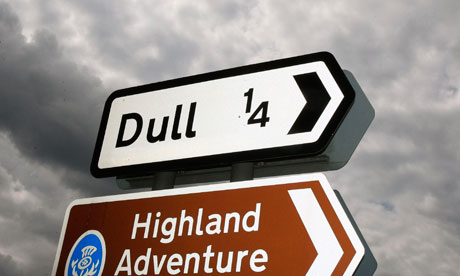Aberfeldy’s original fame is that General Wade built a bridge to cross the Tay in 1733. It is also a nice Victorian town
This commemorates the regument being commissioned to “watch upon the braes” by Wade in 1740
Has Queen Victoria been drinking Boddington’s?
More brilliant window displays
Great to see a cinema being restored.
After Aberfeldy I drove to Kenmore, going past the signpost for the village of Dull, which had just been twinned with the Oregon town of Boring.

At Kenmore there is a “crannog”. I had first noticed reference to these when on Mull. They are artificial islands used as dwellings from the Neolithic period through to C17th. Crannogs typically now appear as small, circular islets, often 10 to 30 yards in diameter, covered in dense vegetation.
At Kenmore there is “an authentic reconsturction”. It was great.

After seeing inside the inside we had demonstrations such as milling and making fire.
A duck very interested in milling/grinding
The following day I visited Cruachan “the hollow mountain” a pumped storage hydro-electric system constructed between 1959 and 1965 and is the first reversible pump storage hydro system to be built in the world, officially opened by the Queen on 15th October 1965.
 The Ben Cruachan Dam
The Ben Cruachan Dam
Water is pumped up from Loch Awe to the upper reservoir, 360 m above, during periods of low energy use (at night). In addition tunnels have been built through Ben Cruachan to catch rain coming from all sides of the mountain - 10% of the energy from the station is generated from rainwater.
Production can go from standby to full in two minutes, thus it is used to deal with periods of peak demand on the grid and can operate for 22 hours before the supply of water in the top reservoir is exhausted. It can power 225,000 houses.
There are four turbines, which operate both as pumps, in reverse as well as generators. The cavern where these are housed required the removal of 220,002 m³ of rock and soil and is 1 kilometre below the ground above and the road access is also 1 kilometre inside the mountain.
The turbine hall is 91.5m long, 23.5m wide and 38m high, and has an adjacent transformer hall. (St Paul’s Cathedral is 111m high). Now the station’s operations are controlled remotely from Cathcart near Glasgow





















No comments:
Post a Comment